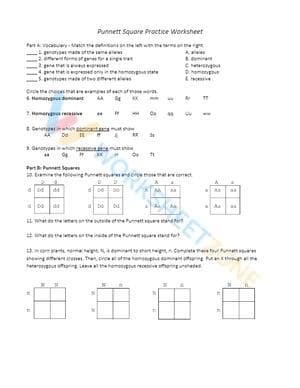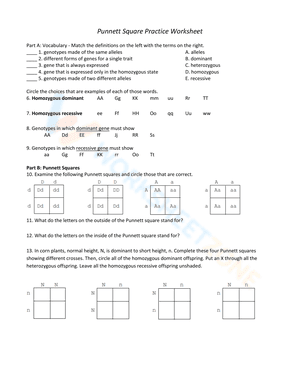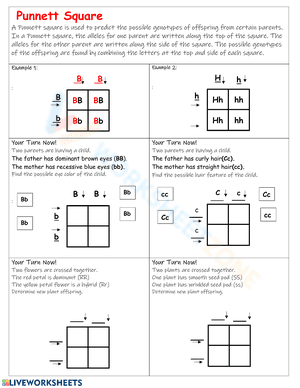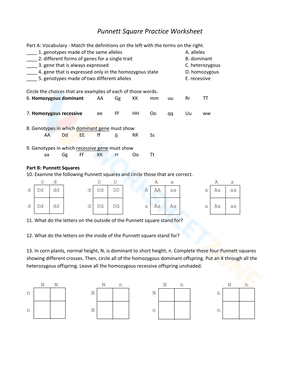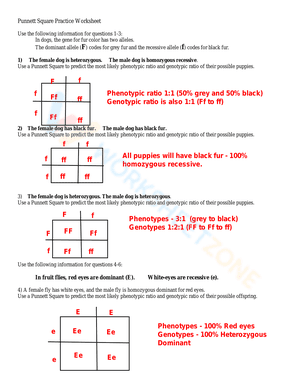On this website, we created this fantastic Punnett Square Practice Worksheet to provide your students with plenty of practice with this important life science concept. Simply download the worksheet and answer key and print as many copies as you need for your class.
This Punnett Square activity can be used in a variety of ways, including as an individual classroom activity, a group exercise to encourage your peers to collaborate, and even as a homework assignment to provide extra support to your children.
With the help of this Punnett squares worksheet, students can model how genes are passed down to offspring! These science worksheets for middle school students ask students to complete and analyze Punnett squares while practicing identifying offspring genotypes and phenotypes. Students will then apply their knowledge of Punnet squares to answer a free-response question, which is an excellent way to sharpen and develop critical-thinking abilities.
Why not use it in your next life science class to assist your students in mastering this topic?
Benefits of Punnett Square Practice Worksheet?
When teaching your kids about Punnett Squares, provide them with some excellent examples to work with. These Punnett Square Worksheets are excellent activities for teaching your children about this important method.
Punnett Squares are an important part of studying genotypes and variation because they show the various possible variations of alleles derived from two parents. This demonstrates how different traits can be passed down to offspring and why different combinations of alleles result in different traits being displayed.
Punnett Square Definition
A Punnett square is a graphical representation of the genotypes that could result from a specific cross or breeding event. Creating a Punnett square necessitates knowledge of the parents' genetic make-up. A tabular format contains all of the possible combinations of their gametes. As a result, each box in the table represents a different fertilization event.
The implicit assumption is that each trait is defined by a single gene locus and that different traits assort independently of one another. Though this is true for many useful traits, particularly when selecting traits for plant or animal breeding, there are numerous exceptions.
This tool was developed in the twentieth century, many years after Mendel's seminal genetic experiments. However, they are now commonly used to explain Mendel's findings, especially when combined with our current understanding of DNA, genes, and chromosomes.
Functions of Punnett Squares
Punnett squares can accurately determine the ratios of various observable traits as well as their underlying genetic composition in large-scale experiments, such as those conducted by Mendel. For example, when a true-breeding tall pea plant is pollinated by pollen from a true-breeding short pea plant, the Punnett square predicts that all of the offspring will be tall and heterozygous for both the allele for shortness and tallness. It can also predict that if these heterozygous plants are allowed to self-fertilize, approximately 75% of the second-generation plants will be tall, while the remaining 25% will be short. One-third of the tall plants will be still true-breeding, while the other two-thirds will be heterozygous. Plant and animal breeders use this tool to select appropriate specimens in order to produce offspring with the desired trait.
They are also used in genetic counseling to assist couples in deciding whether or not to have children. For example, if both parents are carriers of an autosomal recessive disease such as cystic fibrosis, their child has a 25% chance of developing the disease and a 50% chance of becoming a carrier.
However, if one parent has the disease and the other is neither a carrier nor ill, the couple can be confident that their child will not develop cystic fibrosis because she will carry only one copy of the abnormal gene.
Types of Punnett Squares
There are two kinds of Punnett squares that are commonly used. The first is relevant when observing a single trait determined by a single genetic locus. A monohybrid cross is an example of this, as are some of Mendel's original experiments, in which he selected true-breeders for a single trait and crossed them with members carrying a different allele. These are 2 × 2 squares with 4 boxes, each representing one fertilization event between both the parent gametes for a monohybrid cross.
The second version is used to forecast the outcome of breeding experiments involving two traits, and the Punnett square is larger, with 16 boxes. The 4 * 4 square is required because each parent can produce four different types of gametes based on the distribution of the alleles of the two genes.
When there are more than two traits have been observed, a Punnett square becomes too large to handle, and other techniques are used to predict the outcomes of such crosses.
Examples of Punnett Squares
Most people are familiar with Punnett squares because of Mendel's experiments. One of the characteristics of the common pea plant that he recognized was the color of the peas. Other popular examples used to demonstrate this tool's predictive power include the inheritance of blood types and eye color in humans.
Pisum sativum (Common Pea Plant) Seed Color
Mendel developed true-breeding homozygous plants for both alleles, resulting in yellow and green colored seeds. He discovered that if he cross-pollinated these homozygotes, all of the offspring would have yellow seeds. When he allowed these yellow offspring to self-pollinate, he was surprised to discover that nearly 25% of the second generation of pea plants had green seeds. He came to the conclusion that the yellow allele outweighed the green one.
He crossed a few of the initial generation plants with yellow seeds with a true-breeding green plant to understand better this phenomenon. This was later referred to as a test cross.
An allele is represented by the first letter of the dominant phenotype in each Punnett square. The dominant yellow color allele is marked by the capital letter 'Y,' while the recessive allele is marked by the small letter 'y.' Each allele is free to segregate into a gamete on its own, and the gametes are represented just outside the 2 × 2 tables.
Each box represents one possible genotype for the offspring. Half of the offspring in this test cross have yellow seeds and are genotypically heterozygous. The other half is homozygous for green seeds.
Cat Tail and Hair Color
When homozygous short-tailed, white-haired cat mates with a homozygous long-tailed brown-haired cat, all of the offspring appear to inherit one characteristic from each parent. They all have short tails and brown hair, indicating that brown is dominant over white and the short tail allele is dominant over the long tail allele.
When members of this first generation mate, the vast majority of their offspring will be born with short tails and brown hair. Furthermore, there is a three-in-sixteenth chance that the parental combinations of the short tail with white hair or the long tail with brown hair will reappear. Finally, there is a one-in-sixteenth chance that a new combination - long-tailed and white-colored - will appear.
A breeder looking for a long-tailed, white-haired specimen would know that it would only appear in the second generation.
Teachers can make their own Punnett Squares worksheets by using our worksheet maker to best fit their aims.
Limitations of Punnett Squares
While Punnett squares are a useful tool for understanding Mendelian genetics, they are ineffective in many cases involving complex genetic inheritance. They are ineffective, for example, in estimating the distribution of genotypes and phenotypes when two genes are linked. Genetic linkage is the presence of two genes on the same chromosome that are close to each other. As a result, the chances of these two traits being inherited together, in the same combination as found in the parent, are high during gamete formation. One example is the link between the gene causing Nail-patella Syndrome (NPS) and the one determining blood group. A study of one family with NPS discovered that it was frequently inherited along with a B-type blood group. These connections will alter the random distribution of the two traits among offspring, rendering the Punnett square unreliable as a predictor.
Furthermore, Punnett squares cannot predict exactly the distribution of phenotypes in offspring when a single trait is determined by multiple genes and the effect of each of these genes is graded. Over 400 genes are spread across the genome that determines human height. Furthermore, environmental factors such as nutrition have an impact on this trait.
Finally, genes inherited entirely from one parent, such as those in the mitochondria or on the Y-chromosome, as well as genotypes that are lethal to the fetus, muddle the Punnett square outcomes.
Hope that this collection of Punnett square practice worksheets on WorksheetZone can help you get better achievements in learning or teaching biology!
